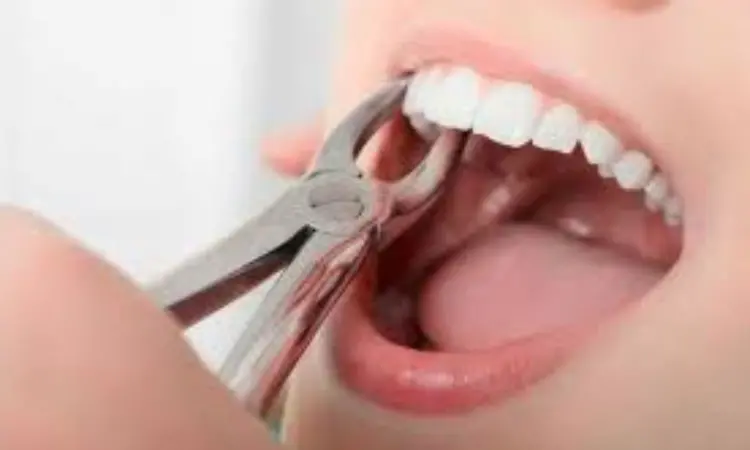- Home
- Medical news & Guidelines
- Anesthesiology
- Cardiology and CTVS
- Critical Care
- Dentistry
- Dermatology
- Diabetes and Endocrinology
- ENT
- Gastroenterology
- Medicine
- Nephrology
- Neurology
- Obstretics-Gynaecology
- Oncology
- Ophthalmology
- Orthopaedics
- Pediatrics-Neonatology
- Psychiatry
- Pulmonology
- Radiology
- Surgery
- Urology
- Laboratory Medicine
- Diet
- Nursing
- Paramedical
- Physiotherapy
- Health news
- Fact Check
- Bone Health Fact Check
- Brain Health Fact Check
- Cancer Related Fact Check
- Child Care Fact Check
- Dental and oral health fact check
- Diabetes and metabolic health fact check
- Diet and Nutrition Fact Check
- Eye and ENT Care Fact Check
- Fitness fact check
- Gut health fact check
- Heart health fact check
- Kidney health fact check
- Medical education fact check
- Men's health fact check
- Respiratory fact check
- Skin and hair care fact check
- Vaccine and Immunization fact check
- Women's health fact check
- AYUSH
- State News
- Andaman and Nicobar Islands
- Andhra Pradesh
- Arunachal Pradesh
- Assam
- Bihar
- Chandigarh
- Chattisgarh
- Dadra and Nagar Haveli
- Daman and Diu
- Delhi
- Goa
- Gujarat
- Haryana
- Himachal Pradesh
- Jammu & Kashmir
- Jharkhand
- Karnataka
- Kerala
- Ladakh
- Lakshadweep
- Madhya Pradesh
- Maharashtra
- Manipur
- Meghalaya
- Mizoram
- Nagaland
- Odisha
- Puducherry
- Punjab
- Rajasthan
- Sikkim
- Tamil Nadu
- Telangana
- Tripura
- Uttar Pradesh
- Uttrakhand
- West Bengal
- Medical Education
- Industry
Rare Case of Hemorrhagic Shock After Dental Extraction Highlights Risks in Patients on Dual Antithrombotic Therapy

France: A recent case report published in the International Journal of Surgery Case Reports has brought attention to a rare but serious complication following routine dental extraction—hemorrhagic shock—in a patient undergoing both anticoagulant and antiplatelet therapy.
Alexia Pouplin, Université de Lorraine, Faculté d'Odontologie, F-54500 Nancy, France, and colleagues detail the experience of a 71-year-old oncology patient who developed life-threatening bleeding episodes after the extraction of two teeth. The first episode occurred just one-day post-surgery, followed by a second bout a week later. Despite the presence of known bleeding risk factors such as advanced age, cancer treatment, and dual antithrombotic therapy (acetylsalicylate of DL-lysine and Tinzaparine), the intensity of the hemorrhage observed was found to be unusually severe and clinically unexplained.
Before the dental procedure, a biological assessment was conducted, and the surgical plan was reviewed and approved by a cardiologist to ensure patient safety. Nevertheless, the patient required red blood cell transfusions and underwent surgical wound revision to achieve hemostasis after the bleeding episodes.
The authors emphasize that while minor bleeding is a known risk in patients on anticoagulant or antiplatelet medications, the development of hemorrhagic shock remains exceedingly rare, particularly following a procedure as common as dental extraction. The report highlights a lack of standardized guidelines in oral surgery for managing patients receiving a combination of oral anticoagulants and antiplatelet drugs—an increasingly common scenario given the aging population and the rising prevalence of cardiovascular conditions and cancer.
Despite thorough evaluation, the researchers could not identify a definitive cause to fully explain the severity of the bleeding in this case. While the patient's comorbidities and medications undoubtedly increased the risk, the clinical team found no precedent in the literature describing such a dramatic presentation under similar conditions.
The case emphasizes the importance of proactive measures to control bleeding during surgery. However, as this case shows, even well-planned interventions may not fully prevent complications in high-risk individuals. Based on this experience, the authors advocate for extended postoperative observation, particularly over the first seven days, in patients with significant bleeding risk factors. This approach may help detect delayed bleeding episodes early and allow timely intervention.
The authors emphasized that although hemorrhagic shock following tooth extraction is an uncommon complication, the case stresses the importance of increased clinical vigilance, thorough interdisciplinary coordination, and prolonged postoperative monitoring in patients with complex medical profiles. They further noted that the case highlights a significant gap in existing clinical guidelines for managing oral surgical procedures in individuals receiving dual antithrombotic therapy.
Reference:
Pouplin, A., Pham Kormann, D., Dolivet, G., & Phulpin, B. (2025). Hemorrhagic shock after dental extractions in a patient with anticoagulant and antiplatelet therapy: A case report. International Journal of Surgery Case Reports, 131, 111375. https://doi.org/10.1016/j.ijscr.2025.111375
Dr Kamal Kant Kohli-MBBS, DTCD- a chest specialist with more than 30 years of practice and a flair for writing clinical articles, Dr Kamal Kant Kohli joined Medical Dialogues as a Chief Editor of Medical News. Besides writing articles, as an editor, he proofreads and verifies all the medical content published on Medical Dialogues including those coming from journals, studies,medical conferences,guidelines etc. Email: drkohli@medicaldialogues.in. Contact no. 011-43720751


